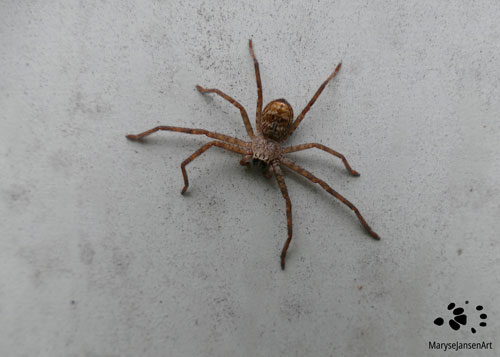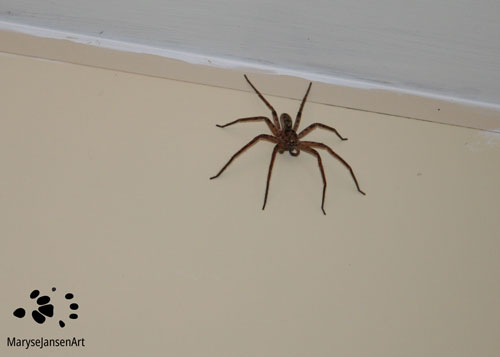Wildlife Photography with marysejansenart
Freak out or tolerate?

Table of Contents
Huntsman Tales
‘Now it’s going to be fun…’, I said to my partner, closing the bathroom door in the cabin firmly behind me. I had spotted a huge, hairy spider on the wall and didn’t feel like being anywhere near it.
We were in Australia for the very first time, travelling from Brisbane to Cairns, and we were slightly influenced by the sensation-seeking documentaries about all the venomous creatures in this country. Having a 4yo with us and not a lot of knowledge about which creatures were dangerous and which ones weren’t, we erred on the safe side and my partner would remove all spiders from each cabin or hotel room before we went to sleep to protect the little one from any possible harm.
He had a quick look and rummaged through the little kitchen to try and find a large bowl to catch it with. He found something that was at best a medium sized bowl. I looked at it and knew it wasn’t going to cut it, but he was determined to try. Carefully he held the bowl up and approached the spider. The spider walked away swiftly. It made a rickety sound on the wall which spooked my partner. ‘I can HEAR it walk!’, he exclaimed. He realized he was out of his depth and closed the bathroom door behind him the way I had done minutes earlier.
‘Now what?’
Local Australian Advice
I had a brilliant idea: I would go out to try and find a local who could help us. However, it was 11pm, pitch black, and it seemed nobody was awake at the campsite anymore… I took a big beamed torch, because I wasn’t going to step on any snakes in the dark either! Finally, I found 2 young lads and approached them with our problem. They turned out to be from Austria… Obviously they didn’t know any more then I did. But, they did know about a local guy who, as they said, might still be awake having a beer at the bar.
We went over to the bar and found him. Thankfully he was happy to help. ‘Oh that’s just a Huntsman’, he said in a thick Aussie accent, ‘completely harmless!’ I found it a bit hard to believe. But the good man came along to our cabin and showed us how to get rid of a Huntsman: ‘Get a broom!’ Gently prod the spider with the broom until it clings on to the hairs of the broom, then bring the broom outside and away you go! ‘Too easy!’
We were very relieved and grateful to this man. And we had learned some valuable lessons: Huntsman spiders are not dangerous and easy to remove from your home. Really, I promise, it is easy! I have done it this way a couple of times now and it works. The good thing is that with the long broom stick you don’t have to get close to the spider and also the spider doesn’t get hurt this way.

Huntsman Spiders are Hunters
Huntsman spiders are a group of spiders that is widely distributed throughout Australia. There are more then 90 known species of Huntsman in Australia! They can grow as big as the size of your hand (like the spider from the story above!) and have long, crab-like legs, which is why they are also sometimes referred to as crab-spiders.
Huntsman spiders do not build webs. Instead, they hunt for their food, which consists of insects and other invertebrates. Generally these spiders are quite shy. During the day they hide in crevices, such as in the bark of a tree. At night, they come out to hunt.
In an urban environment they may find hiding places in your house or car. During day time they might sometimes come out of their hiding spots when they are disturbed. Most likely you will see them walk on your walls or ceilings in the evening, when they are on the hunt. Their size, hairiness and the speed with which they walk are enough reasons for a lot of people to freak out when they see one. They also have the ability to jump off the walls, another good way to spook a human being!
The Bite of a Huntsman
They can bite and most Huntsman bites only cause mild local pain and swelling. The bite of one species however, the Badge Huntsman, may be more painful and can cause nausea, headaches and palpitations, so it’s best not to provoke them. Even though the bites are generally not medically significant, ‘Completely harmless’, may be a bit of an understatement. But the good news is you don’t have to fear for your life either.
When a female spider is protecting her egg sack or recently hatched young she gets a bit more aggressive. It is a good time to keep your distance. Be aware that each egg sack may contain up to 200 eggs! Most of the little spiderlings will not survive, as they have many predators including geckos, birds and Spider Wasps.
Why would you tolerate a Huntsman in your home?
Many people see these spiders as a natural form of pest control and tolerate them around the house. Others rather put them out in the garden. They are great to help reduce the number of cockroaches, flies and mosquitos at your place!
And as a bonus, by keeping insect numbers under control, they keep other, more dangerous spiders away from your house as well!
Since that first encounter 14 years ago, I have now come to appreciate the Huntsman Spiders – especially because they eat cockroaches! I’m at the point where I happily tolerate them inside until they get really big and then I prefer to see them go outside. How about you?
If you are interested in purchasing ‘Brown Huntsman Spider’ or would like to see what the image looks like on the various products, please head to my shop.
In the latest episode in my ‘Come for a walk in the Australian Bush’-series, you won’t find a Huntsman. However, it does showcase lots of other interesting spiders!


